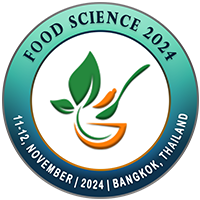
Nicoleta Stanciuc
University of Galati, RomaniaTitle: Inactivation kinetics of Lactiplantibacillus (Lpb.) plantarum MIUG BL21 using different individual and combined treatments on a kinetic basis
Abstract
Fundamental limitations are
reported for the use of probiotics, such as the ability of the cells to remain
alive and active in the food matrix before consumption, the resistance in the
upper gastrointestinal tract and the ability to live and grow in the tract, the
capacity to exert beneficial effects while in the tract, while no toxic or
pathogenic activity is accepted. Recently, a new concept of biotics was
introduced, such as paraprobiotics or “ghost probiotics” defined as ”non-viable
microbial cells (intact or ruptured) or raw cellular extracts (with complex
chemical composition), which when administered (orally or topically) in
adequate amounts, confer a benefit to the human or animal consumer”. To date,
limited studies report the kinetics of probiotics inactivation, as prerequisites
to produce paraprobiotics. In our study, in order to produce paraprobiotics as
inactivated cells, different individual (thermal, ohmic heating, high pressure,
and ultrasound) and combined (ohmic, high pressure and ultrasound in
combination with heating) treatments on Lactiplantibacillus (Lpb.) plantarum
MIUG BL21 inactivation were applied. Different inactivation rates (expressed as
log N/N0) were suggested, up to 8.18 after 10 min at 90°C, 2.07 after 15 min at
a voltage gradient of 20 V/cm, 6.62 after 10 min of
treatment at 600 MPa and 3.6 after ultrasound treatment for 10 min at 100%
amplitude. The experimental inactivation data were fitted to Weibull model and
Peleg model, allowing to estimate the b and n parameters.
Biography
Nicoleta
Stanciuc has 46 years and her current position is Professor at the Faculty of
Food Science and Engineering (FSE), Dunărea de Jos University of Galați.
She teaches courses on food safety and food quality, food traceability,
functional foods, food quality and safety management systems in food industry.
She has competence on assessment the process-structure-function-products
relationship of targeted biologically active compounds, intrinsic indicators to
quantitatively evaluate the impact of physical preservation/processing
techniques in terms of food safety and functionality, valorisation of highly
nutritional and functional by-products from food industry, microencapsulation
of active ingredients and application of microencapsulation for the safe delivery
of bioactive in food system.

